MAG - Miami Art Guide,
December 2004
ArtSpace / Virginia
Miller Galleries
Introducing significant artists to South Florida's Art Community for more than
35 years
By Abel S.
Virginia
Miller, described by a leading magazine as "the
undisputed doyenne of South Florida art dealers," has
presented more than 300 public exhibitions of art ranging
from works by acknowledged masters to the initial exhibitions
of emerging artists, all with several common characteristics. "The
work that I've shown reflects my taste and my judgment," said
the veteran art dealer. "I've always tried to
show work that I thought presented a unique personal
vision, that has long-term artistic significance, and
lastly, that represents good value to my clients."
As the owner and director of Greater
Miami's longest-established contemporary fine art
gallery, Miller can reflect on the many exhibitions
she has curated and designed since 1974 at the gallery's
original location in Coconut Grove, at a 9,000-square-foot
space at Douglas Center, in annex galleries at the
Biltmore Hotel in Coral Gables and Miamarina in downtown
Miami, as well as in such other venues as the Boca
Raton Museum of Art and the Fine Arts Gallery of
Broward Community College and in her present gallery
in downtown Coral Gables. |
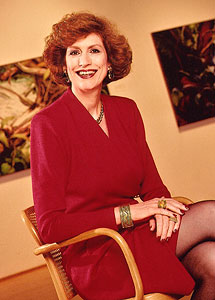 |
For nearly 38 years, as a private
dealer and as a gallery owner, Virginia Miller has introduced
and exhibited emerging and mid-career artists as well
as a number of historically significant 20th century
masters to South Florida. Some of her exhibitions have
been spectacular. "Karel Appel
flew in from Monaco for his one-person show of sculpture
and paintings," Miller said. "One of his sculptures
of a windmill with clouds floating through its blades was
about eight feet tall.
| |
"When we did an installation
of grass growing in the shape of the late Ana Mendieta's
body, Ana's sister Raquel, who was doing the installation,
wanted us to use long grass but we could only find
sod," Miller recalls. "We put plastic sheeting
on top of our hardwood floor and installed the sod
on a mound of topsoil, and Raquel used a template
to cut out the shape of Ana's body. She filled it
with dead leaves that she brought from New York.
"Because of the air-conditioning,
we were concerned about the grass drying out, so
I had the gallery assistant water it twice a day.
Within a few days it began to grow, and then it grew
some more. During the two-month course of the exhibition,
that grass grew to about ten inches high–it
was amazing."
|
Three thirteen-foot
dugout canoes containing real skeletons highlighted the
one-person exhibition of Sharon Kopriva, who makes near-life-size
mummified effigies out of bones, hair, horns, leather,
and papier mache. The exhibit was so spectacular that WPLG-TV
newscaster Todd Tongen did two live broadcasts featuring
the exhibition.
Another
memorable one-person exhibit documented light
sculpture by Eric Staller. The high-light of the
show was his "Lightmobile," a VW Beetle
studded with 1,659 tiny light bulbs flashing in computer-generated
patterns. "At night, we took the Lightmobile
out on the road with all of its lights flashing various
patterns," Miller said. "People remembered
seeing it in the movie 'The Money Pit.' Everyone
honked at us, and when we stopped in Coconut Grove
it really attracted a crowd. The Miami Herald ran
a big picture and story about it in color on the
front page of the local section."
Some of the gallery's
shows have been controversial, such as Fernando Luis'
one-person exhibition of lascivious priests and pregnant
nuns, or contemporary Russian art years before glasnost
and perestroika, when the Soviet Union was still
viewed as our nation's enemy.
Other criteria for
exhibitions presented by Miller has been a highly
accomplished technique and the "spirit" or
artistic integrity of the work. "I've always
believed that a dealer in contemporary art has a
great responsibility to help people learn how to
look at art, to feel what it's about, and not to
be intimidated by new art forms," she stated. |
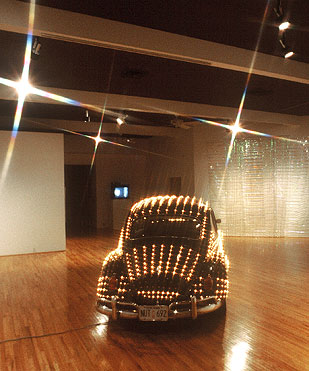 |
Eric Staller "Lightmobile"
|
top |
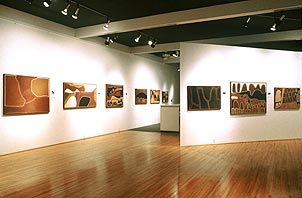 |
Australian
Aboriginal Artists
|
|
ArtSpace / Virginia
Miller Galleries exhibits at such expositions as
Art Miami, Art Palm Beach, and Arte Americas. "Blink," its
most recent exhibition at Art Miami's "Currents," the
section of cutting-edge works, featured more than
a hundred miniscule photographs, each mounted on
a clear acrylic sphere the size of a ping-pong
ball. The work of Russian artist Anatolij
Shuravlev,
the dangling spheres turned and refracted their
changing environment, which included a line of
88 fingernail-sized photos mounted on another wall.
Outside the booth, an elliptical installation included
another 400 of Shuravlev's minuscule works.
"When a photograph is only
three-eighths of an inch square, you have to really
scrutinize it to see its subject matter," Miller
said. "The line of photos on one wall was
of Russian architecture and monuments. The outside
installation pictures were American movie stars
and other celebrities. But the tiny ones on the
hanging balls were the most popular–they
included a number of beautiful male and female
nudes."
Miller's start in the art field
was as unique as the works she sells. After working
in a law firm and bank, then managing an advertising
agency, she decided to return to college. As an
undergraduate, she met a number of artists who
complained that local galleries only wanted to
exhibit nation-ally known artists.
With her business
and advertising background, Miller saw an opportunity,
and soon she was organizing exhibitions of fine
art, mostly to benefit local charities. Beginning
in the late 1960s, those exhibitions at Temple
Beth Sholom, First National Bank of South Miami,
Citizens Federal Savings and Loan Association,
Fellowship House, United Cerebral Palsy Association
of Miami, and other venues may well have made local
art history as Dade County's first synergism of
art and business.
top
|
Introducing significant artists to South Florida
After opening her gallery in 1974,
seven years after she began dealing in art, Miller sought
out and curated major exhibitions of a number of important
artists who had never before exhibited in the region.
In 1978 she exhibited a retrospective of Alice Neel's
works on paper dating from 1926 to 1977. It was Neel's
first exhibition in Florida. Along with the exhibition,
the gallery showed the award-winning
public television film, "Alice Neel: Collector of
Souls."
Included
in the exhibition was Neel's six-foot portrait of
Miller, done shortly after the art dealer and Neel
met while serving on panels during a seminar at Manhattan's
prestigious New School. "While I was posing
for my portrait, I persuaded her to show the historic
works by offering to dredge them out of the nooks
and crannies of her rambling apartment in Spanish
Harlem," Miller recalled. "When
I went back there to select works for her show, my husband and I spent most
of a day dragging dusty paintings from beneath her bed and out of the depths
of her closets," Miller recalls.
Clearly, Neel had not seen many
of the works for a long while. Years before, an irate
lover had cut up and burned 60 of her paintings and
200 drawings and watercolors. From time to time as
the artist saw an artwork she exclaimed, "I
thought that son-of-a-bitch had burned that one!" The
Alice Neel retrospective was reviewed in national
arts magazines and newspapers. Until then largely
overlooked by the art establishment, within a few
years Neel was featured on the cover of Time magazine
as one of the century's most important portrait artists.
About that same
time, Miller arranged for the first exhibition of
models and architectural drawings by SITE, the multidisciplinary
art and architecture organization from New York City.
The SITE team had created a number of nationally
publicized "de-constructed" buildings
around the nation, including two in Greater Miami.
Miller arranged for two Grey-hound buses, complete
with live music and snacks on the road, to take art
enthusiasts to tour them after the opening reception.
Many
of the works from the SITE architectural exhibition
went on to be shown in Ronald Feldman Fine Arts in
New York and at the Museum of Modern Art. In 1983
Miller scored a national coup with a world-wide exclusive
exhibition and sale of "Doonesbury" animation
drawings and paintings. "Doonesbury" animation
art is rarely seen on the market, as Garry Trudeau
only allows it to be sold to benefit select charities—in
this case, for abused children.
The following year ArtSpace/Virginia
Miller Galleries mounted one of its largest exhibitions:
more than 130 images from 19th and 20th century master
photographers. Including works by the inventor of
the photographic negative, William Henry Fox Talbot,
and the first woman photographer, Anna Atkins, the
show presented a history of photography, including
works by the early Europeans, the American pictorialists
and the then-courant colorists, such as Elliott Porter,
represented by a pair of oversize dye transfers.
In 1985 the gallery presented another
historic blockbuster: "Richard Pousette-Dart:
Paintings: From the 1940s to the Present." It
was the first exhibition in the South for Pousette-Dart,
youngest member of the New York School of abstract
expressionists. "I found out why no one had
sought him out to show his work," Miller recalls.
|
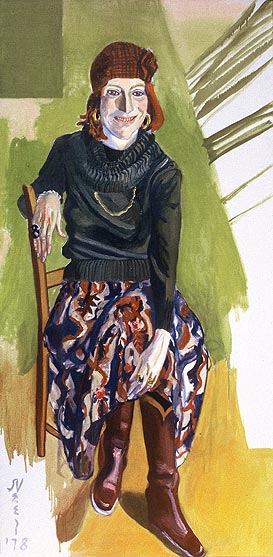 |
Virginia
Miller by Alice Neel |
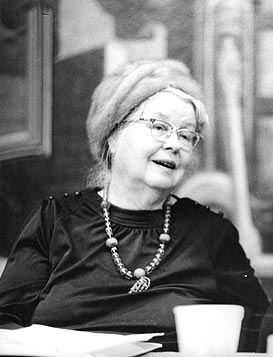 |
Alice Neel |
|
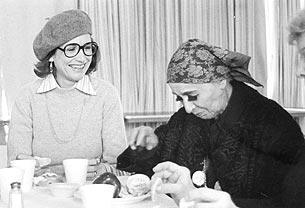 |
Louise Nevelson and Virginia
Miller
|
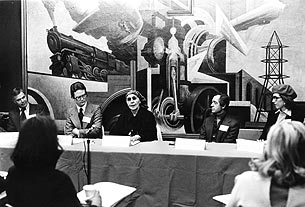 |
Louise Nevelson and Virginia
Miller
|
top |
"Every time I selected a
painting, he would put it back and say 'Not that
one.' Eventually, he complimented me on my 'eye'
in selecting his best work, and he let me have
enough pieces for a major retrospective – but
he wanted to pull them off the truck as they were
being loaded.
"He was one
of those painters who goes back to a painting year
after year to work on it some more, and I suppose
he felt those works weren't really finished, even
though they had been painted ten or even twenty
years earlier," Miller
said. The following year Miller did a second Pousette-Dart
exhibition, "Magical Radiances: Black and
White" that included works from 1978 to 1981.
That exhibition coincided with a one-person Pousette-Dart
show at the Fort Lauderdale Museum of Art.
The gallery made international history again in
December 1990, when Laurence Gartel used digital
cameras developed by Canon for the Gulf War to
photograph visitors as they entered the gallery
and the first large toner printer, the Canon Bubble
Jet, to output manipulated color prints of their
images. "It was fun to see how Larry could
shoot photos of people as they entered the gallery,
manipulate them on a computer, and then print them
out right away," Miller said. "Everyone
does it to-day, but it was phenomenal at that time." Gartel,
whose book, "Laurence M. Gartel, A Cybernetic
Romance" (Gibbs Smith, 1989, illustrations
by Nam June Paik) is considered the first book
on an individual's computer-generated art, believes
the event was the first time in history digital
art was produced at a gallery's opening reception.
|
In 1992
ArtSpace/Virginia Miller Galleries presented Florida's
first major exhibition and sale of Australian aboriginal
art, "Walk About In The Dream-time." Its
guest of honor was Rover Thomas, a founder of the
Turkey Creek School of aboriginal art and one of
two Aborigine painters who had rep-resented Australia
in the Venice Biennale.
"Rover speaks five aboriginal
languages, but doesn't know a lot of English," Miller
said. "His sense of humor was wonderful. When
I walked toward him from across the room he would
turn to my husband, smile and say, 'Boss come.
"When I took him to the Foundlings
Club to talk about his art, about all he could do
is point to a mark on one of his pictures, give us
a big smile, and say, 'Water.' Aboriginal 'dreamings'
often represent a sort of map of their desert, so
locating water was the most important thing he wanted
us to know about. Fortunately, we had another member
of their community present to give us some insight
into the work and the aboriginal culture."
In 1998 the gallery
presented a major exhibition of paintings by Ramon
Oviedo, the leading master artist of the Dominican
Republic. Called "one of the greatest masters
in Latin American contemporary art" by the late
Jose Gomez Sicre, director of the Organization of
American States Museum, Oviedo had never had a major
exhibition in the United States. Guests at the Oviedo
opening included the award-winning Latin jazz composer
and performer Chichi Peralta and members of his band.
Peralta presented the gallery his most recent CD,
which is always among the selections played during
openings for Latin artists.
In the spring of 2004, ArtSpace/Virginia Miller Galleries
presented the latest in its series of exhibitions
of modern masters. "Gunther Gerzso:Defining
Mexican Abstraction" featured 86 works done
from 1935 to 1978 by Mexico's leading abstract artist,
a stellar figure in the pantheon of Latin American
artists. The exhibition was a world premiere of most
of the 1935-41 works as well as the first time Gerzso's
works had been presented in a major exhibition in
the southeastern United States.
"The drawings and paintings were done when Gerzso
was the set and costume designer at the Cleveland
Playhouse," Miller said. "Gerzso was only
in his 20s, but the playhouse director recognized
that he had a budding master artist and so he collected
everything young Gerzso produced.
"When the director died a few years ago, about
400 of Gerzso's early works–the largest archive
of any modern master artist available today – were
discovered in a trunk in a back room of the playhouse.
The Santa Barbara Museum spent two years documenting
them and a selection of them was included in their
catalog and major traveling exhibition of Gerzso's
work."
|
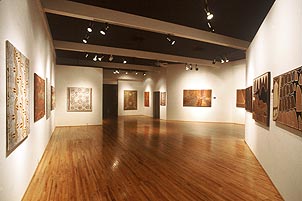 |
Australian
Aboriginal Artists |
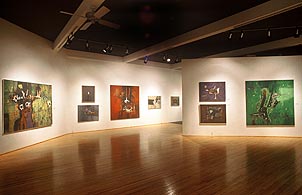 |
Ramon Oviedo |
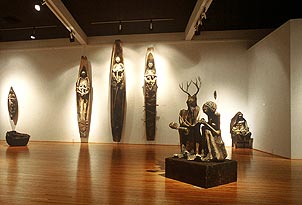 |
Sharon Kopriva |
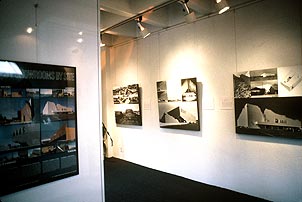 |
Architectural
Exhibition |
top |
top |
Miller commissioned
two of the nation's largest bronze sculptures, a
sprawling 36 by 78-foot installation on Biscayne
Bay in Miami and a 60-foot-tall work at the International
Airport in Omaha, Nebraska, both by John Raimondi.
Other public sculptures
commissioned by Miller include a larger-than-life
bronze of baseball immortal Joe DiMaggio and a small
boy at the Joe DiMaggio Children's Hospital in Hollywood,
Florida, by Zenos Frudakis. Miller's article on outdoor
sculpture for Collector-Investor magazine was full
of advice for anyone contemplating an outdoor work,
particularly one in the subtropics or near salt water. "Artists
often have to learn through costly experience that
designs that look wonderful don't always work outdoors," Miller
said. "I help my clients select out-door works
that will look great year after year and require
less maintenance."
Miller has received
international recognition in publications ranging
from the New York Times to Artnews magazine, which
gave her a full-page testimonial in 1988 for the
quality of her exhibitions and community involvement.
Arte al Dia International included her in its People
in Art interviews for its 100th Anniversary Issue.
Miami Magazine included Ms. Miller in a special section
with the notation: "The six-foot redhead is
a cultural explosion all by herself." She was
featured in Town and Country magazine in February
1996. Referring to her gallery's longevity, Lear's
magazine declared her the doyenne of South Florida
art dealers. |
If
pressed, Miller can cite numerous stories about how works
that she sold have appreciated in value, but she does so
reluctantly. "I've never told anyone to buy
a work of art simply as an investment, and I never will," Miller
said. "Early on, I chose to ignore the latest trends
and instead to show only works that I personally relate
to and artists that I believe in," says Virginia Miller. "I've
al-ways insisted that my clients buy only works that they
love. Although many of those works have appre¬ciated
in value substantially, I urge clients not to consider
their art acquisitions merely as a financial investment,
but as an investment in their quality of life." Judging
by the number of grateful letters received by Miller from
clients who bought work from her years before, her philosophy
has proven successful.
(Some photos were added by gallery to illustrate this
article and did not appear in the original.)
top
To go back to News click Here
|
